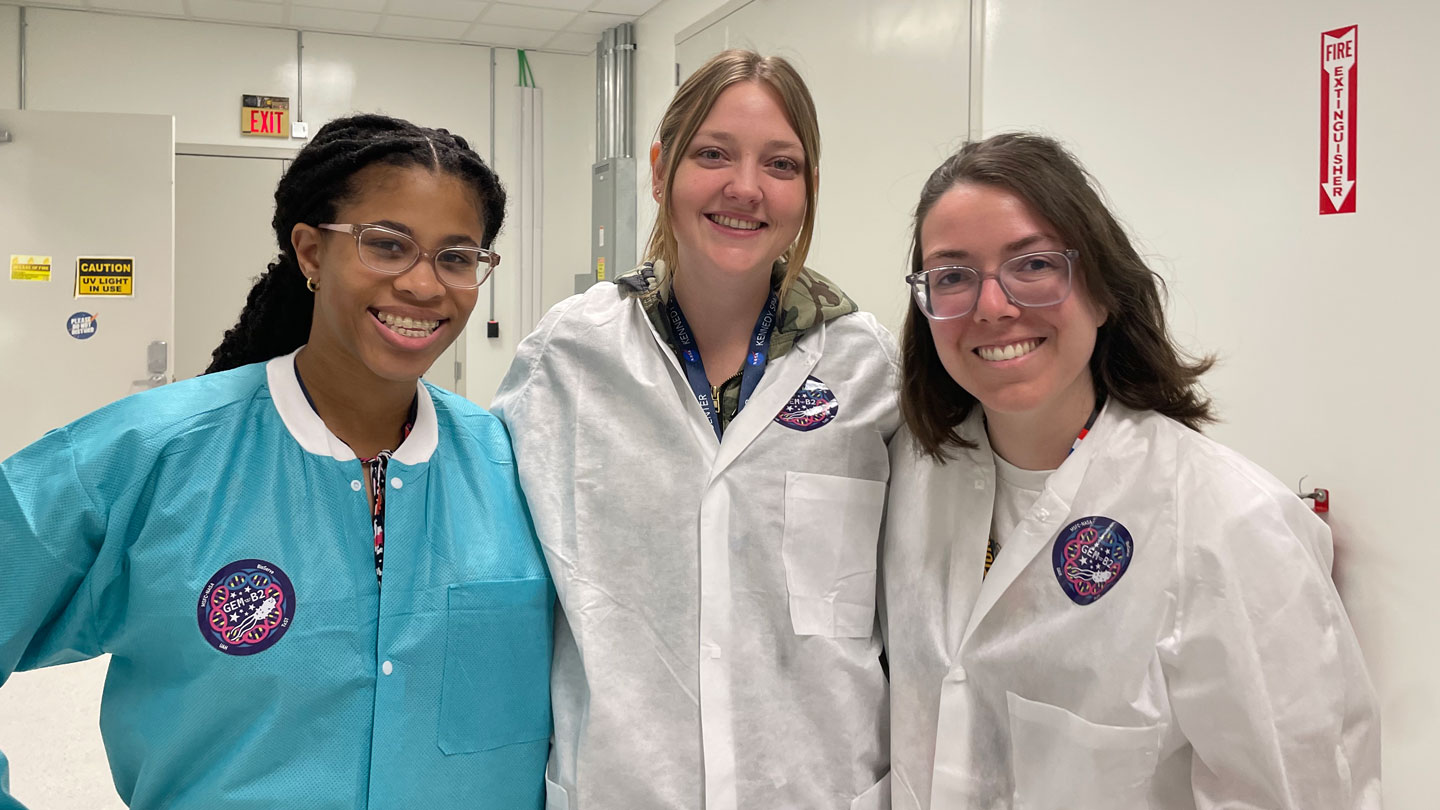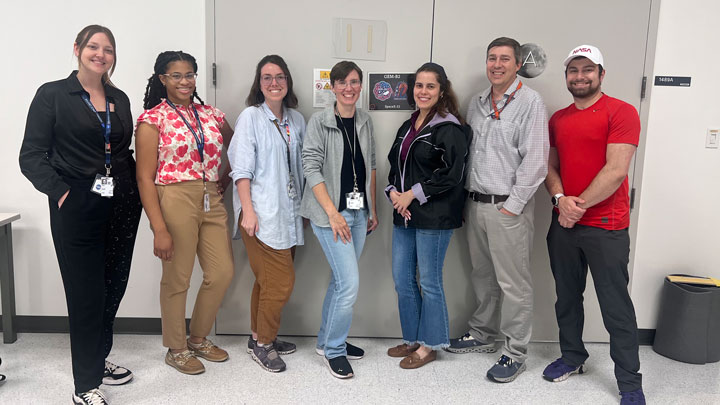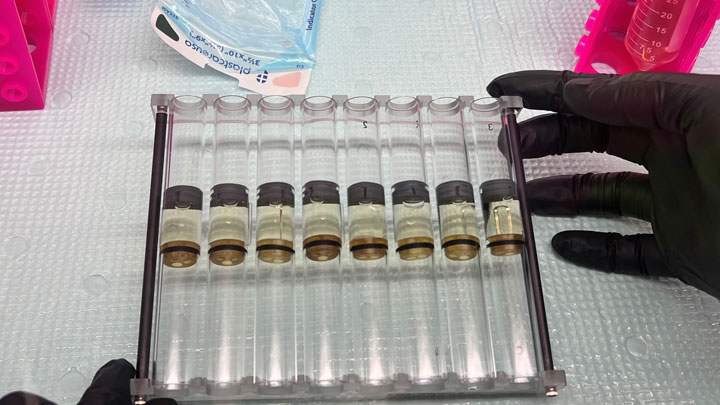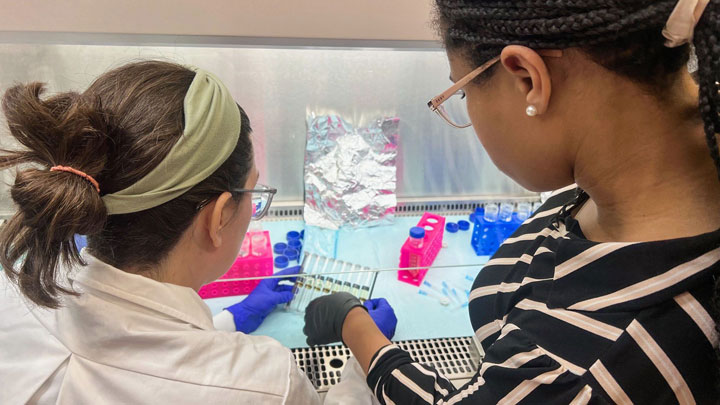
Graduate students upon completion of flight sample preparation at the Kennedy Space Center laboratory. (L-R), Lanie Briggs (UAH), Taylor Ranson (Texas State), Amy LeBleu DeBartola (UAH).
Courtesy Tanya Sysoeva
On April 21, at 4:15 A.M. EDT, samples from the UAH Biology Sysoeva Lab were launched into orbit as part of NASA’s SpaceX CRS-32 resupply mission to the International Space Station (ISS). The mission will carry out the Genetic Exchange in Microgravity for Biofilm Bioremediation, or GEM-B2 experiment. A collaborative project between The University of Alabama in Huntsville (UAH), NASA Marshall Space Flight Center (MSFC), Texas State University and Bioserve at the University of Colorado Boulder, the experiment is designed to study how microgravity affects gene transfer amongst microbial cells.
This project was started several years ago by Dr. Yo-Ann Velez Justiniano and Dr. Tanya Sysoeva at UAH, a part of The University of Alabama System, to work towards addressing obstructive biofilms found in the ISS Environmental Control and Life Support Systems (ECLSS). Biofilms are mats of microbial or fungal growth that can clog hoses or filters in water processing systems or potentially cause illness in humans.

GEM-B2 team at NASA Kennedy Space Center (KSC) laboratory before launch. (L–R), Taylor Ranson (TSU), Lanie Briggs (UAH), Amy LeBleu DeBartola (UAH), Tanya Sysoeva (UAH), Yo-Ann Vélez Justiniano (MSFC), Jonathan Wilson (MSFC), Eric Bietle (MSFC).
Courtesy Bob McLean
A grant was awarded to the ECLSS ISS Urine Processor Sustaining Lead, Jonathan Wilson, NASA MSFC, to lead the collaborative effort as part of the NASA POLARIS Program, an initiative that focuses on research and technological advancements related to human health, spaceflight impacts on the human body and developing technologies for extended space travel.
At UAH, the Sysoeva Lab completed the ground pre-flight validation and optimization of the experiment, which included determining which bacterial systems and conjugative plasmids are best to use in measuring the transfer of conjugative plasmids in microgravity.
Conjugative plasmids are extra-chromosomal DNA elements that are capable of horizontal transmission and are found in many bacteria, while conjugation refers to the transfer of plasmid DNA from a donor bacterium to a recipient cell. In the selected conjugative systems researchers look at different time points to best capture differences as the bacteria encounter each other under nominal gravity on Earth and in the low-sheer microgravity environment of the ISS. Further biological constraints included working out the optimal amounts of bacteria to use, along with modeling how the effects of cold stowage transport would affect the longevity and potency of the microbes and chemicals.
“Conjugative plasmids tend to spread genes converting bacteria into antibiotic resistant strains, and thus are the main mechanism of the current global spread of antimicrobial resistance in human pathogens that we study in our group,” Sysoeva notes. “This is a unique opportunity for us to continue mechanistic characterization of this fundamental process of gene transfer under reduced gravity conditions at ISS to add to the basic understanding as well as make the first steps to implement this knowledge in remediation strategies.”

Checking for contamination upon completion of the first sterile chambers at the fluid processing assembly (FPA).
Courtesy BioServe
While previous Earth studies have shown that biofilms might stimulate gene transfer through conjugation, this study aims to measure how precisely microgravity affects this gene transfer. The goal is to develop a bioremediation method to reduce or prevent biofilm formation inside the water systems at the ISS and other, future human space habitats, such as the Artemis Lunar Gateway. The GEM-B2 ISS payload experiment is a first step to analyze the effects of microgravity on bacterial conjugative gene transfer using two kinds of conjugative plasmids.
In conjunction with their partners, UAH researchers successfully completed ground validation testing by performing a mock trial run of the GEM-B2 experiment validation test with similar temperatures and time points to what the experiment will experience in traveling to and from the ISS.
Elanie Briggs, a Ph.D. student studying Biotechnology Science and Engineering (BSE) at UAH, says she never imagined working on a project like this. “For me, this whole experience has felt surreal. My earliest memories of space were simply stargazing with my dad at distant planets through his telescope. Space science and exploration always seemed far removed from my scope.
“In my early academic years, I assumed my path would lead me to just be another scientist producing good work but blending into the background of scientific progress,” the student notes. Now, as a part of the NASA POLARIS GEM-B2 spaceflight project, Briggs says she “gets to be something more. I am an ambitious microbiologist helping to shape the future, contributing to research that could extend beyond Earth. Through this experiment studying gene transfer in bacterial conjugation systems, I am not only learning but also helping to push the limits of space biology.”

(L-R) Researchers Amy LeBleu DeBartola and Lanie Briggs preparing samples for EVT at Sysoeva lab at UAH.
Courtesy BioServe
Another Ph.D. student in the BSE program at UAH contributing to the experiment is Amy LeBleu-DeBartola. She says working on this project has been a dream come true. “I have been fascinated by space for over 18 years now,” the student researcher says, crediting her love of space from an early visit to Huntsville. “Huntsville is where I caught Rocket Fever by participating in Space Camp.”
After earning undergraduate degrees in physics/astronomy and biochemistry, as well as a graduate degree in planetary science from the University of Central Florida, LeBleu-DeBartola chose Huntsville for her Ph.D.
“Being able to be a key member of the science team on an ISS payload this early in my career is astounding,” LeBleu-DeBortola says. “I am so honored to be trusted to be able to help with the ground validation experimental design for temperature testing, selecting a bacterial system and final experimental design.”